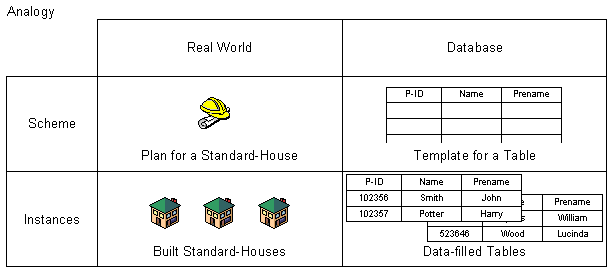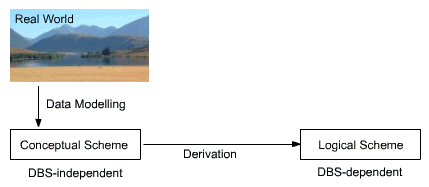|
|
Database Schemes and Database Instances
Independent from the database model it is important to differentiate between the description of the database and the database
itself. The description of the database is called database scheme or also ![]() metadata. The database scheme is defined during the database design process and changes very rarely afterwards.
metadata. The database scheme is defined during the database design process and changes very rarely afterwards.
The actual content of the database, the data, changes often over the years. A database state at a specific time defined through
the currently existing content and relationship and their attributes is called a database instance
The following illustration shows that a database scheme could be looked at like a template or building plan for one or several
database instances.
 Analogy Database Schemes and Building Plans
Analogy Database Schemes and Building PlansWhen designing a database it is differentiated between two levels of abstraction and their respective data schemes, the conceptual and the logical data scheme.
- Conceptual Data Scheme: :
- A conceptual data scheme is a system independent data description. That means that it is independent from the database or computer systems used. (Translated) (ZEHNDER 1998)
- Logical Data Scheme:
- A logical data scheme describes the data in a data definition language DDL of a specific database management system. (Translated) (ZEHNDER 1998)
A logical data scheme describes the data in a data definition language DDL of a specific database management system.
(Translated) (ZEHNDER 1998)
The conceptual data scheme orients itself exclusively by the database application and therefore by the real world. It does
not consider any data technical infrastructure like DBMS or computer systems, which are eventually employed.![]() Entity relationship diagrams and relations are tools for the development of a conceptual scheme.
Entity relationship diagrams and relations are tools for the development of a conceptual scheme.
When designing a database the conceptual data scheme is derived from the logical data scheme (see unit Relational Database Design). This derivation results in a logical data scheme for one specific application and one specific DBMS. A DB-Development System
converts then the logical scheme directly into instructions for the DBMS.
 Schematic Represenation of the Different Schemes
Schematic Represenation of the Different Schemes